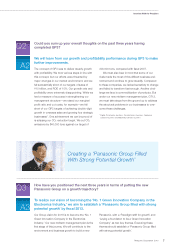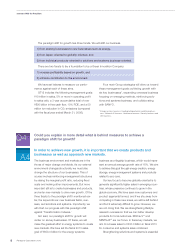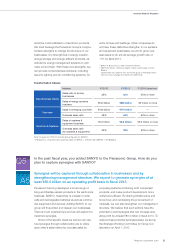Panasonic 2010 Annual Report Download - page 18
Download and view the complete annual report
Please find page 18 of the 2010 Panasonic annual report below. You can navigate through the pages in the report by either clicking on the pages listed below, or by using the keyword search tool below to find specific information within the annual report.
We will utilize Panasonic’s strength in consumer products and
SANYO’s strength in commercial-use products as the corner-
stone of our strategy in this business.
In the European air conditioner market, we plan to increase
the number of equipment sales dealers, including those spe-
cializing in air conditioning. We have not made enough prog-
ress in developing these sales channels up to now. In
emerging countries, we will leverage low-noise and energy-
saving technologies to focus on local leader models that
match local needs.
Energy Management
Panasonic is focused on businesses related to energy creation,
energy storage and energy saving. Energy creation involves the
generation of electricity with solar cells, fuel cells and other
technologies, while energy storage entails the provision of
rechargeable batteries for wide-ranging applications from home
to commercial use. Energy saving is a field we are tackling in all
manner of areas including home electronics. In addition, we
want to lead the world in energy management that helps cut
electricity consumption in entire homes and entire buildings by
linking and optimally controlling devices and equipment.
We are developing and testing systems for the integrated
control of electric power, temperature and information of
devices and equipment toward the full-scale roll-out of the
energy management business. Our goal is to create a system
for the visual display of electricity consumption, hot water
supply and other information and detailed control by network-
ing appliances and facilities in homes.
We are continuing to develop related products for an AC/
Heating/Refrigeration/
Air Conditioning Business
In commercial-use products, we will extend our lineup,
targeting markets in Japan, Europe, China and elsewhere in
Asia. This lineup will include large-sized air conditioning and
heat-pump water heating systems, as well as commercial-use
freezers and showcases.
We will also actively propose comprehensive solutions for
entire stores. We already propose comprehensive control
systems combining cooling and heating conditioning systems
and energy systems to convenience stores and supermarkets.
We plan to step up these activities.
Others
Dehumidifiers/
Humidifiers/
Air Purifiers
Commercial-use
Freezers/Showcases
Heat-Pump Systems
Commercial
Air Conditioners
Room Air
Conditioners
670
540*
* Figures for FY2010 include annual sales figures for SANYO.
2013
2010
Sales Target
(Billion yen)
Average Annual
Growth Rate
7.4%
In this business, Panasonic aims to generate sales of ¥670.0 billion in fiscal 2013 by achieving an annual
average growth rate of 7.4%.
DC hybrid wiring system that will reduce energy loss during
electric current conversion.
The Corporate Division for Promoting Energy Solutions,
which was set up on April 1, 2010, will lead and accelerate the
development of cross-domain energy systems products in the
Panasonic Group.
Products Related to Eco-Cars
For eco-cars, we will accelerate the development of three
businesses: batteries, thermal management systems, and
power supply management systems.
We will develop batteries for a wide range of eco-cars,
including electric vehicles (EVs) and hybrid cars, as well as
low-cost standard modules.
In thermal management systems, our aim is to increase
comfort as well as driving distance by applying energy-saving
technology developed for home-use air conditioners.
With power supply management systems, we plan to build
systems to make charging highly efficient, safe and quick.
Fiscal
( Year
)
16 Panasonic Corporation 2010
Special Feature
























